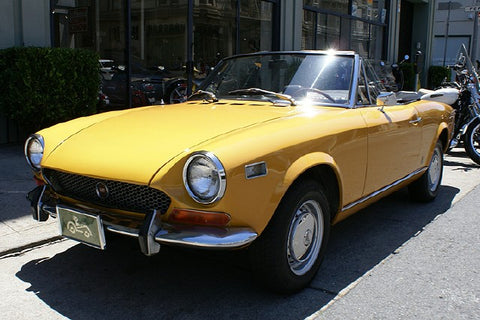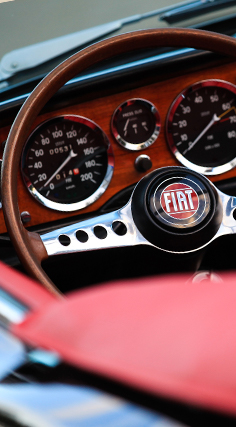1966-85 Fiat 124 Spider History
The Spider version of the Fiat 124 was introduced in the fall of 1966 at the Turin motor show. The body was designed by Tom Tjaarda who worked at Pininfarina and also designed some of the most beautiful Ferraris of the time. Production started in late 1966 with only 166 cars completed before the production line was shut down for the holidays.

The first version of the Spider was dubbed 124 AS, ‘A’ meaning the first version and ‘S’ for Spider. These early cars were much simpler in some details than the later versions. There was no radio console or console between the seats. The heater controls were in a pod under the dash and the heater box was visible. The seats had no headrest and there were many chrome accents in the cabin: the steering wheel spokes, the instrument bezels, and the rearview mirror trim were all shiny. A single circuit brake system was used, and the accelerator pedal was bottom hinged, like many Fiats of the 60s.

In 1968 the Spider was readied for the US market, which required some changes, a few of which carried over to all markets. All Spiders acquired a radio console and a lower console sourced from the 124 Coupe, and only the instrument bezels retained their chrome finish. The hydraulic brake system became dual circuit. The US market cars had round side-markers front and rear, headrests, bumper overriders, a reverse light under the left bumper, and the engine was de-tuned to comply with US emissions regulations. Another change in late 1968 (1969 model year in the US) altered the rear suspension. Fiat gave up on the torque tube setup in favor of a simpler system using upper and lower trailing arms.

The ‘B’ series 124 Spider (ie. BS) was introduced in late 1969 (1970 model year in the US) and it carried several cosmetic changes. The grille was now a honeycomb style, the taillights grew larger and incorporated the reverse lights, the gauges were deeply recessed, the upper radiator support was farther forward to make room for an electric fan, and the side-markers incorporated a separate light and reflector (the US only).

The 1971 model year brought bigger news. The 1608cc engine was now available, and in Europe, it sported dual Weber IDF carburetors and developed 110HP. The US market engines were again detuned making only 104 gross/94 net HP on a single carburetor. Contemporary road test praised the added torque of the new engine. Gone was the bottom hinged gas pedal and the US-market side-markers were changed to a simpler rectangular unit. A curiosity is that the tachometer on the 1608cc engined Spiders read to 9000rpm (8000 on all others), although the redline was lowered to 6500 from the 1438’s 6800 rpm. These cars were designated as ‘BS1’, and are considered by some as one of the best versions. For an unknown reason, the US 1971 model year Spider and some of the 1972s had slightly different taillights, which were about 10mm wider than the previous ones. These lights are very hard to find in good condition today, as they have not been available new for decades.

In November of 1972, Fiat introduced the 124 Rally, the Abarth rally homologation version of the Spider. In order to use the car for rallying, Fiat had to build at least 500 street going versions of the rally car. These Spiders were quite different in that they had independent rear suspension, reinforced front suspension, a roll-bar and hardtop as standard equipment, no convertible top, racing bucket seats and simplified interior. The homologation specials had a 128 HP version of the 1756cc engine, but the actual race cars had a lot more. Fiat did win some rallies with the Abarth Spider, but once the Fiat 131 became available Fiat decided that it would be better marketing to rally their bread and butter sedan instead of a sports car.

The next regular version also came in 1972 (1973 model year in the US) when Fiat introduced the new 132 series Twin –Cam engines. They were available in 1592 and 1756cc sizes. In Europe, one could choose their engine size, but in the US the 1973 model year had the 1592cc engine and 1974 and on had the larger one. On US models the bumpers were now set a few inches away from the body and mounted to the structure of the car via large rubber blocks. The California and Maryland versions also had large rubber blocks instead of overriders. The European models retained the same bumpers as before. The 1974 US model was the first one to include a host of new emissions equipment, such as exhaust gas recirculation and air injection. Still, the 1974 US model Spider had a fairly large carburetor (Weber 34DMSA) and a twin down-pipe exhaust, so it made fairly good power.

That all changed for the 1975 model year. Spiders were no longer available outside of North America and the engine performance was further strangled. The carburetor now was smaller (Weber 32ADFA) and the exhaust had a single down-pipe. 49-state models still managed without a catalytic converter, but 124 Spiders bound for California had one. Another major change for 1975 was the large impact bumpers which were now required by US Federal regulations. While they looked much better than those on some other contemporary sports cars, most enthusiasts were not impressed. The front turn signals were now integrated into the bumper and not on the body.
There were few changes between 1975 and 1978, but there was a slight redesign in the middle of the 1977 model year. The air horns were eliminated in favor of conventional dual tone electric horns, the oil pressure gauge was deemed non-essential, the alternator moved to the intake side of the engine and now was internally regulated, and the center dash warning lights were now all rectangular. Fiat also moved the relays from the engine compartment to inside the car, under the glovebox.
Late during the 1978 model year (but not at the same time), Fiat started changing a few things that would eventually appear in the next model year. The door handles changed to the flush type, the rear axle adopted the 131’s design and shoulder belts finally appeared.

The 1979 model year saw a major update of the 124 Spider. To denote the larger engine size the name was changed to Fiat Spider 2000. The larger engine produced noticeably more torque, but no more power because of the emissions controls. The entire appearance of the car was modernized both inside and out and an automatic transmission plus power windows became options.
The revised exterior included larger bumps on the hood and new taillights, the side markers were now flush with the body, the exterior mirror was a modern black plastic unit, the wiper blades were larger and black, a ‘2000’ badge appeared next to the right taillight which incorporated the trunk lock, the hood sported a chrome trim at the leading edge to match the grille opening, and the wheels were styled steel affairs in a four-leaf clover pattern. Metallic paint colors were finally available and all Spiders had a stylish front spoiler.
Inside the seats were more modern, the dash and the upper door panels were color coordinated, the steering wheel became a sporty threes spoke design, the shift knob was made of wood, shoulder belts were standard and lost the dual reels of the previous model year. The vent window latches were of a more modern design, the hazard switch became round, and the defroster vents on the dash were now fixed. Blue and burgundy were new interior colors.
For the first half of the 1980 model year Spiders were identical to the 1979 ones, save for different style steel wheels, but the cars made from the second half of that year had a great upgrade: they sported Bosch fuel injection. Power and fuel economy increased, while the engine was smoother than ever before. To announce this the rear ’2000’ badge now also said ‘fuel injection’. The only change in the interior at this time was the relocation of the round hazard switch from the dash to the radio console.

During the 1980 and 1981 model years Fiat made available a limited edition 50th anniversary model (of Pininfarina). These cars had a tan leather interior, a brown dash and steering wheel, a special metallic color, plus special badging on the side and the dash, which also had the car’s number. There were one thousand made, but some cars were damaged at the port, so fewer were actually sold. Around this time one could also buy a standard Spider with leather option, which had identical interiors to the anniversary Spiders but came in regular exterior colors. The anniversary cars came with 14-inch “iron cross” alloy wheels, the same design as the optional 13-inch alloy wheel on the regular Spiders.
The 1981 and 1982 model years were nearly identical to the fuel injected 1980. One visible change was the exterior mirror, which had a much thinner stem for a smoother look. 14” alloy wheels are more common on these cars. A rare option was the turbocharged engine. Fiat commissioned Legend Industries in New York to install a turbocharger on a few hundred Spiders and these were sold through the regular dealer network. The turbo Spiders were only a bit more powerful but had a lot more torque than the standard Spider and fully functional examples are now a rare sight.

Another big change came for the 1983 model year when Pininfarina took over full production of the Spider as Fiat no longer wanted to market it. The car was renamed the Pininfarina Spider and was relaunched in Europe as the Spider Europa. In 1984 it was renamed the Azzurra, in honor of Italy’s sailboat entry into the Louis Vuitton Cup. There were many small but significant changes. The most visible one was the exterior mirrors. For the first time Spiders came standard with left and right mirrors that were mounted in the fixed vent windows, and the side emblems changed from the ‘f’ symbol to the Pininfarina script. There were also changes in the interior. The center console was redesigned to a vertical design integral with the dashboard and it incorporated a pair of fresh air vents. The hazard switch was a more modern design and among the standard equipment was power windows and a remote electric trunk opener. There was no longer a rear seat, instead, a convenient parcel shelf was installed.
Also launched in 1983 for markets outside of the USA was the supercharged Volumex Spider. It used the 2 liter carbureted supercharged engine found in other Fiat and Lancia vehicles of the era. It developed 135 HP and a lot more torque than the stock engine. To deal with the higher power these cars had larger vented front brake discs and other modifications. Only about 500 were produced.

In September of 1984, the Spider went through a major modernization. The most notable changes were the adoption of rack and pinion steering and larger front brakes. There were also a lot of small improvements that went a long way to making the Spider more modern. There were new, wider, alloy wheels, a cooling system with a pressurized overflow tank, shorter shift lever, more vertical steering wheel, and the gauges were repositioned for better visibility. These latest Spiders, unofficially called 1985.5, are the best driving Spiders of all. Unfortunately not much later Pininfarina received a contract from Cadillac to build the Allante bodies, and 124 Spider productions ended with the last cars rolling off the assembly line around May of 1985.
For identification by model number, check out our informative Classic FIAT 124 Spider Model Identification page.


